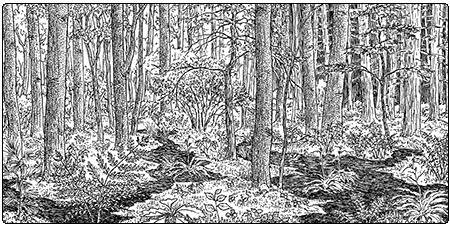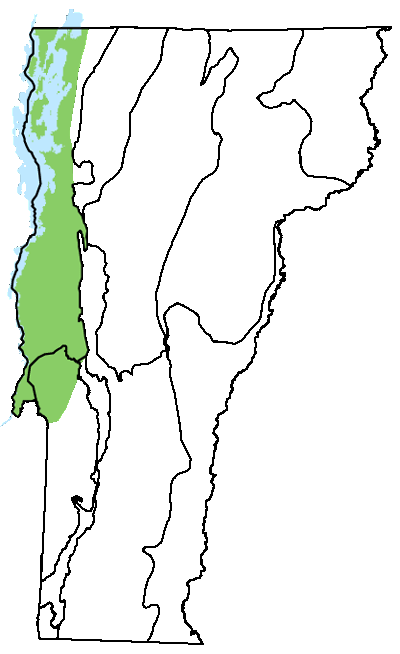Ecology and Physical Setting
Wet Sand-Over-Clay Forests occur on flat plains in the Champlain Valley, where sand deposits cover fertile clays. These sands were deposited where swiftly flowing rivers entered the former Glacial Lake Vermont and the Champlain Sea, so today they line some of our major rivers. The locations of Wet-Sand-Over-Clay Forests are a window into the geologic past.
The soils either have a sandy layer over clay (Swanton, Whately, and Enosburg soils) or have deep sand deposits with a high-water table and no apparent clay layer (Carbora, Au Gres, Searsport, and Wareham soils). In both cases, the result is a seasonally high water table that saturates the soils well into the spring, determining what plant species can be present. Soil fertility varies, and may depend on the mineral content of the ground water or the depth to the impeding fertile clays.
Surface organic layers vary with site hydrology. Sites with long-duration saturation have deeper organic layers. On the drier sites, surface organic layers may be only an inch or two thick.
Although these are wetlands, even hollows that are wet in spring can dry out in the summer.
Wet Sand-Over-Clay Forest is one of the natural communities of the clayplain forest ecosystem, which is described under the Mesic Clayplain Forest natural community.
Vegetation
The canopies of Wet Sand-Over-Clay Forests are typically closed, but occasional small openings are created when shallow-rooted trees topple over. Most sites are dominated by a mixture of deciduous trees and hemlock, although hemlock can dominate locally or even form a nearly complete canopy in some forests. The dominant deciduous species are green ash, red maple, yellow birch, and swamp white oak. Other trees include white pine, red oak, white oak, and bur oak. Musclewood is common in the understory, and black gum, an uncommon species in Vermont, occurs in several examples. Enrichment indicators such as black ash and northern white cedar are found occasionally. Shrubs include winterberry holly, arrowwood, highbush blueberry, mountain holly, and swamp dewberry.
Hummocks are low and small, while hollows are shallow and broad, and contain standing water in the spring. Herbaceous cover is abundant under hardwood canopies, but tends to be sparse under hemlock canopies. The hollows support cinnamon fern, sensitive fern, royal fern, marsh fern, long sedge, hop sedge, Tuckerman’s sedge, fringed sedge, and bladder sedge. Other common wet-site herbs include spotted water-hemlock, fowl mannagrass, and drooping woodreed. The hummocks support species such as sarsaparilla, goldthread, and Canada mayflower that cannot withstand the seasonal flooding that occurs in the hollows. Most of these wet forests lack herbs indicative of enrichment.
Wildlife Habitat
As a small patch community within the clayplain forest ecosystem, the wildlife habitat of Wet Sand-Over-Clay Forest is closely tied to the size and condition of this surrounding forest matrix. Gray treefrogs may be heard and seen in these forests, especially when they occur near permanent, shallow water marshes. The shallow-rooted trees in these wet forests lead to an abundance of tip-ups, and the exposed root masses provide ideal habitat for winter wren. Veery and great crested flycatchers also breed in these wet forests. Shagbark hickory can be abundant in some forests. Its loose plates of bark provide summer roosting habitat for Indiana bat. The uncommon hickory hairstreak butterfly relies on its namesake tree as a host plant. Male hickory hairstreaks court females by flashing their wings high in the canopy. Females lay eggs singly on the underside of hickory leaves, where the eggs overwinter. In spring, the larvae emerge to feed on the leaves.
Related Communities
- Sand-Over-Clay Forest, an upland forest, occurs on drier soils. Hemlock and red maple are typically dominant, but are mixed with white oak, sugar maple, beech, red oak, and white pine.
- Wet Clayplain Forest, a wetland forest, occurs on poorly drained clay soils. Green ash, swamp white oak, black ash, bur oak, American elm, and red maple are the most abundant trees.
Conservation Status and Management Considerations
This small patch wetland community was once much more extensive than it is today. Many of the best remaining examples are conserved, but all occurrences of this rare community deserve permanent protection. This is a community that needs restoration of species composition, natural ecological processes, and connections to other natural communities.
Distribution/Abundance
This rare natural community is restricted to the lower Champlain Valley, often near the mouths of rivers entering Lake Champlain. A similar community has been described in southeastern Michigan along Lake Erie; similar settings also occur along Lake Ontario and in the Saint Lawrence Valley.
Characteristic Plants
Trees
Abundant Species
Green ash – Fraxinus pennsylvanica
Red maple – Acer rubrum
Eastern hemlock – Tsuga canadensis
Yellow birch – Betula alleghaniensis
Swamp white oak – Quercus bicolor
Occasional to Locally Abundant Species
White pine – Pinus strobus
Red oak – Quercus rubra
White oak – Quercus alba
Bur oak – Quercus macrocarpa
Shagbark hickory – Carya ovata
Musclewood – Carpinus caroliniana
Black ash – Fraxinus nigra
Northern white cedar – Thuja occidentalis
Shrubs
Winterberry holly – Ilex verticillata
Arrowwood – Viburnum dentatum
Highbush blueberry – Vaccinium corymbosum
Mountain holly – Ilex mucronata
Herbs
Cinnamon fern – Osmundastrum cinnamomeum
Sensitive fern – Onoclea sensibilis
Long sedge – Carex folliculata
Swamp dewberry – Rubus hispidus
Spotted water-hemlock – Cicuta maculata
Marsh fern – Thelypteris palustris
Royal fern – Osmunda regalis
False nettle – Boehmeria cylindrica
Tuckerman’s sedge – Carex tuckermanii
Hop sedge – Carex lupulina
Fowl mannagrass – Glyceria striata
Drooping woodreed – Cinna latifolia
Skunk cabbage – Symplocarpus foetidus
Slender mannagrass – Glyceria melicaria
Bryophytes
Moss – Sphagnum centrale
Moss – Hypnum imponens
Three-lobed bazzania – Bazzania trilobata
Rare and Uncommon Plants
Virginia chain fern – Woodwardia virginica
Yellow bartonia – Bartonia virginica
American hazelnut – Corylus americana
Black gum – Nyssa sylvatica
Associated Animals
Gray treefrog – Hyla versicolor
Winter wren – Troglodytes hiemalis
Veery – Catharus fuscescens
Great crested flycatcher – Myiarchus crinitus
Rare and Uncommon Animals
Indiana bat – Myotis sodalis
Red-shouldered hawk – Buteo lineatus
Hickory hairstreak – Satyrium caryaevorus
Places to Visit
LaPlatte River Marsh Natural Area, Shelburne, The Nature Conservancy
Little Otter Creek Wildlife Management Area, Ferrisburgh, Vermont Fish and Wildlife Department (VFWD)
Lower Otter Creek Wildlife Management Area, Ferrisburgh, VFWD
